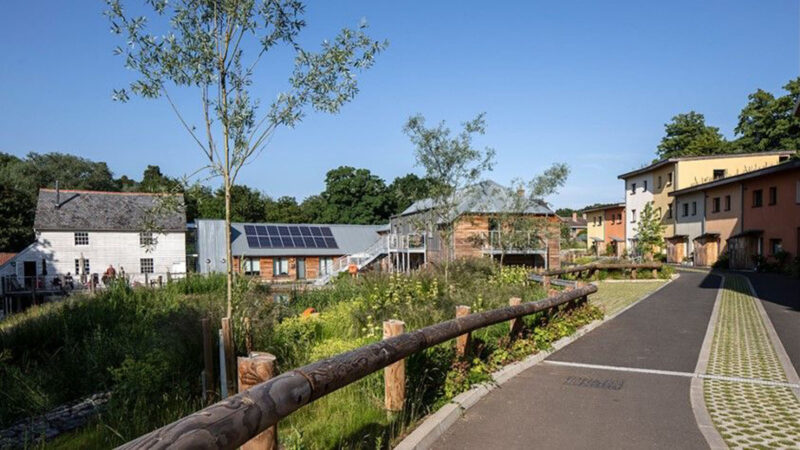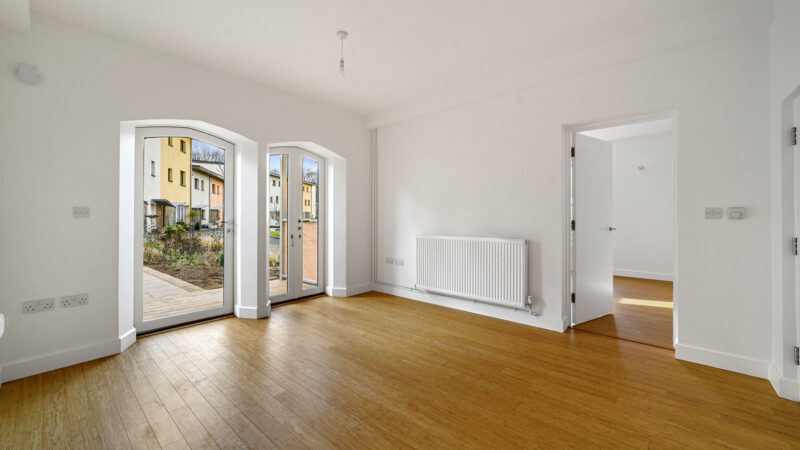Originally formed in London, Cannock Mill Cohousing is a community of 26 homes in Colchester, who share a commitment to eco-living and having fun while working hard.
| Number of homes | 26 market value homes |
| Location | Colchester |
| Project Stage | Built 2019, extended 2023 |
| jump to project video | |
How they formed
The seven founders originally lived in London and gathered a larger group by persuading others to join a group called London and Countryside Cohousing (LoCoCo). By 2009, there were enough people committed to the concept to incorporate a company limited by guaretee, with all members as directors. Each member was part of at least 2 sub-groups during the development phases, such as finance or social activities. There were monthly Board meetings to ensure all members were up to date on current work and included in discussions.
The group focuses on low energy and environmentally friendly living and see the benefits of living in an intentional community such as this. This shared interest of eco-living is reflected through the development in the low energy homes, solar power generation, and shared vegetable gardens. Whilst the group currently includes people over 50, this is not a restriction, and anyone is welcome to join.
Site
The group established a site brief, including being in reasonable reach of London, and in a vibrant town rather than a rural location. The sites within reach were often constrained for conventional developers in some way. They looked at and visited a huge range of sites across the Southeast, and systematically compared them. They considered partnerships with some of the landowners. Some sites we considered with a housing association, but there was never sufficient alignment in objectives.
Some sites were considered in detail, but had to be withdrawn from after many months of legal work. There was learning from each experience, and they investigated internal and external financing options in parallel.
In 2013, they visited several sites in East Anglia, one of which was Cannock Mill, a listed water mill, 20 mins walk from the centre of Colchester, complete with pond and adjacent to woodland. Having an architect as a founder member was useful in assessing site feasibility quickly. Most members decided to proceed, although some members dropped out, either due to the location or simply the risk of putting significant sums together to buy the site. It wasn’t until July 2014 that the purchase of the Cannock Mill site was confirmed.
Finance
The group had to find money in advance to purchase the land, finance the design, planning permission and site preparations, to match the development loan. The process through which members made a proper financial commitment to the project accelerated when a suitable site was identified, as the company had to have ready money in the bank to compete with developers.
The group asked members to lend the company at least 10% of the estimated cost of each home, but encouraged those who were able, and willing, to invest more. Collectively they were able to advance more than half the money for the scheme, from selling properties and either downsizing or renting, pension drawdowns, or from savings.
They recognised the need to recruit further members, and to negotiate an external loan. Lenders were impressed by the personal financial commitment which reduced their risk. Lower external borrowing also meant lower interest payments.
In parallel with talking to other lenders, they applied for the Home Builders Loan Fund equivalent in 2014. Cannock Mill have been fortunate to draw on the professional skills and hard work of members on the negotiations, preparation and completion of legal documents and directors loan agreements. This took place at the same time as achieving planning permission, doing preliminary works on site, and appointing a contractor for the main building work, such that the loan could be signed and drawn down in 2017.
The prices of homes were not fixed until they were finished, as the full attributable cost (including the common house) could change, and there was no buffer of a ‘developer’s margin’. Members had to accept the risk that budgeted prices may rise.
Design and Construction
In line with the group’s eco-living ethos, the 23 homes were designed and built to ‘Passivhaus’ standards. The design was led by Anne Thorne who was a member of the group. Anne Thorn Architects were paid standard scale rates for their work. The construction went out to tender in Summer 2016 and was completed in 2019. Alongside the individual homes there is a common house in the listed watermill building, which has been renovated to now provide a kitchen and dining room, lounge, library, guest rooms, and workshops, with full disabled access. The mill pond has also been restored. The two-acre site also includes vegetable gardens, water gardens and wildflower areas.
Living there
Members moved in the 23 Passivhaus homes in late 2019. As well as cooking and eating together, and managing most aspects of the grounds and buildings, residents enjoy sharing interests in music, film, cycling, walking, meditation, gardening, birding, bee-keeping, politics, pottery and a variety of arts and crafts.
The project is structured in a way that individual homes have continued obligations to contribute to communal running costs. Both flats and houses are sold to directors of the company on 999 year leases. There are legal steps to discourage leaseholders from changing their tenure to freehold and to continue to collect a share of running costs from any freehold. All homes are subject to a service charge covering normal expenses, such as insurance and maintenance, and an apportionment of similar costs on the common house. Members make decisions on all costs, and therefore control the service charge.
They have also recently completed renovating an imposing Victorian house built by one of the original Millers to create a further 3 low-energy two-bed flats, complete with heat pumps, solar panels and mechanical heating and ventilation systems.
Read more about the experience in the press

